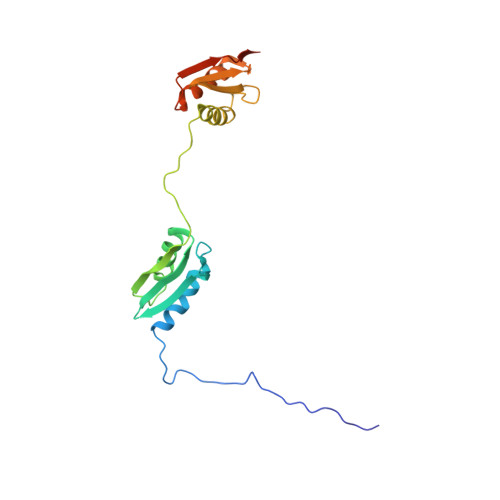The Structure and Function of the Bacterial Osmotically Inducible Protein Y.
Iyer, A., Frallicciardi, J., le Paige, U.B.A., Narasimhan, S., Luo, Y., Sieiro, P.A., Syga, L., van den Brekel, F., Tran, B.M., Tjioe, R., Schuurman-Wolters, G., Stuart, M.C.A., Baldus, M., van Ingen, H., Poolman, B.(2024) J Mol Biology 436: 168668-168668
- PubMed: 38908784
- DOI: https://doi.org/10.1016/j.jmb.2024.168668
- Primary Citation of Related Structures:
8RJX - PubMed Abstract:
The ability to adapt to osmotically diverse and fluctuating environments is critical to the survival and resilience of bacteria that colonize the human gut and urinary tract. Environmental stress often provides cross-protection against other challenges and increases antibiotic tolerance of bacteria. Thus, it is critical to understand how E. coli and other microbes survive and adapt to stress conditions. The osmotically inducible protein Y (OsmY) is significantly upregulated in response to hypertonicity. Yet its function remains unknown for decades. We determined the solution structure and dynamics of OsmY by nuclear magnetic resonance spectroscopy, which revealed that the two Bacterial OsmY and Nodulation (BON) domains of the protein are flexibly linked under low- and high-salinity conditions. In-cell solid-state NMR further indicates that there are no gross structural changes in OsmY as a function of osmotic stress. Using cryo-electron and super-resolution fluorescence microscopy, we show that OsmY attenuates plasmolysis-induced structural changes in E. coli and improves the time to growth resumption after osmotic upshift. Structure-guided mutational and functional studies demonstrate that exposed hydrophobic residues in the BON1 domain are critical for the function of OsmY. We find no evidence for membrane interaction of the BON domains of OsmY, contrary to current assumptions. Instead, at high ionic strength, we observe an interaction with the water channel, AqpZ. Thus, OsmY does not play a simple structural role in E. coli but may influence a cascade of osmoregulatory functions of the cell.
- Department of Biochemistry, Groningen Biomolecular Sciences and Biotechnology Institute, University of Groningen, Nijenborgh 4, 9747 AG Groningen, The Netherlands. Electronic address: a.s.iyer@rug.nl.
Organizational Affiliation:
















